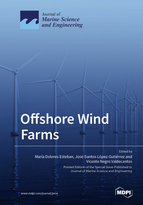Offshore Wind Farms
A special issue of Journal of Marine Science and Engineering (ISSN 2077-1312). This special issue belongs to the section "Ocean Engineering".
Deadline for manuscript submissions: closed (30 September 2019) | Viewed by 71980
Special Issue Editors
2. Department of Civil Engineering, European University of Madrid, 28670 Madrid, Spain
Interests: marine renewable energy; offshore wind; wave energy; maritime engineering; coastal engineering; offshore engineering
Special Issues, Collections and Topics in MDPI journals
Interests: marine renewable energy; offshore wind; wave energy; maritime engineering; coastal engineering; offshore engineering
Special Issues, Collections and Topics in MDPI journals
Interests: marine renewable energy; offshore wind; wave energy; maritime engineering; coastal engineering; offshore engineering
Special Issues, Collections and Topics in MDPI journals
Special Issue Information
Dear Colleagues,
Offshore wind power is one of the renewable energy sources that is currently considered in the energy mix of some countries, and its use will increase in the future. At the end of 2017, there were a total of 18,814 MW of offshore wind installed worldwide, with the United Kingdom, Germany, China, Denmark and the Netherlands leading the way. The aim of this Special Issue is to put together papers that reflect the current state of the art of the offshore wind industry, covering all the aspects to be taken into account for the planning, design, construction, operation and maintenance and dismantling of the facilities, etc.
This Special Issue invites contributions that deal with all the previously mentioned aspects (but is not limited to them), including the following topics: legislation, environmental, wind resources, foundations and support structures, wind turbine generators, electrical connection, etc.
Dr. M. Dolores Esteban
Dr. José-Santos López-Gutiérrez
Dr. Vicente Negro
Guest Editors
Manuscript Submission Information
Manuscripts should be submitted online at www.mdpi.com by registering and logging in to this website. Once you are registered, click here to go to the submission form. Manuscripts can be submitted until the deadline. All submissions that pass pre-check are peer-reviewed. Accepted papers will be published continuously in the journal (as soon as accepted) and will be listed together on the special issue website. Research articles, review articles as well as short communications are invited. For planned papers, a title and short abstract (about 100 words) can be sent to the Editorial Office for announcement on this website.
Submitted manuscripts should not have been published previously, nor be under consideration for publication elsewhere (except conference proceedings papers). All manuscripts are thoroughly refereed through a single-blind peer-review process. A guide for authors and other relevant information for submission of manuscripts is available on the Instructions for Authors page. Journal of Marine Science and Engineering is an international peer-reviewed open access monthly journal published by MDPI.
Please visit the Instructions for Authors page before submitting a manuscript. The Article Processing Charge (APC) for publication in this open access journal is 2600 CHF (Swiss Francs). Submitted papers should be well formatted and use good English. Authors may use MDPI's English editing service prior to publication or during author revisions.
Keywords
- Offshore wind farm
- Marine energy
- Foundations
- Wind resource
- Wind turbine generators
- Electrical connection
- Numerical models
- Physical models
- Development, design and construction
- Operation and maintenance








